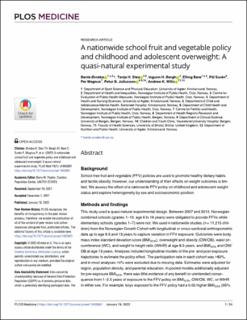| dc.description.abstract | Background
School free fruit and vegetable (FFV) policies are used to promote healthy dietary habits and tackle obesity; however, our understanding of their effects on weight outcomes is limited. We assess the effect of a nationwide FFV policy on childhood and adolescent weight status and explore heterogeneity by sex and socioeconomic position.
Methods and findings
This study used a quasi-natural experimental design. Between 2007 and 2014, Norwegian combined schools (grades 1–10, age 6 to 16 years) were obligated to provide FFVs while elementary schools (grades 1–7) were not. We used 4 nationwide studies (n = 11,215 children) from the Norwegian Growth Cohort with longitudinal or cross-sectional anthropometric data up to age 8.5 and 13 years to capture variation in FFV exposure. Outcomes were body mass index standard deviation score (BMISDS), overweight and obesity (OW/OB), waist circumference (WC), and weight to height ratio (WtHR) at age 8.5 years, and BMISDS and OW/OB at age 13 years. Analyses included longitudinal models of the pre- and post-exposure trajectories to estimate the policy effect. The participation rate in each cohort was >80%, and in most analyses <4% were excluded due to missing data. Estimates were adjusted for region, population density, and parental education. In pooled models additionally adjusted for pre-exposure BMISDS, there was little evidence of any benefit or unintended consequence from 1–2.5 years of exposure to the FFV policy on BMISDS, OW/OB, WC, or WtHR in either sex. For example, boys exposed to the FFV policy had a 0.05 higher BMISDS (95% CI: −0.04, 0.14), a 1.20-fold higher odds of OW/OB (95% CI: 0.86, 1.66) and a 0.3 cm bigger WC (95% CI: −0.3, 0.8); while exposed girls had a 0.04 higher BMISDS (95% CI: −0.04, 0.13), a 1.03 fold higher odds of OW/OB (95% CI: 0.75, 1.39), and a 0-cm difference in WC (95% CI: −0.6, 0.6). There was evidence of heterogeneity in the policy effect estimates at 8.5 years across cohorts and socioeconomic position; however, these results were inconsistent with other comparisons. Analysis at age 13 years, after 4 years of policy exposure, also showed little evidence of an effect on BMISDS or OW/OB. The main limitations of this study are the potential for residual confounding and exposure misclassification, despite efforts to minimize their impact on conclusions.
Conclusions
In this study we observed little evidence that the Norwegian nationwide FFV policy had any notable beneficial effect or unintended consequence on weight status among Norwegian children and adolescents. | en_US |

